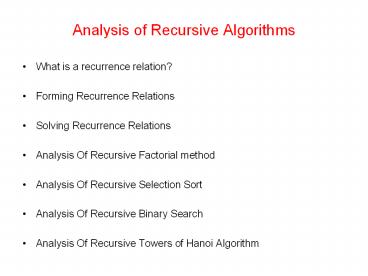Analysis of Recursive Algorithms - PowerPoint PPT Presentation
1 / 12
Title:
Analysis of Recursive Algorithms
Description:
Analysis of Recursive Algorithms What is a recurrence relation? Forming Recurrence Relations Solving Recurrence Relations Analysis Of Recursive Factorial method – PowerPoint PPT presentation
Number of Views:92
Avg rating:3.0/5.0
Title: Analysis of Recursive Algorithms
1
Analysis of Recursive Algorithms
- What is a recurrence relation?
- Forming Recurrence Relations
- Solving Recurrence Relations
- Analysis Of Recursive Factorial method
- Analysis Of Recursive Selection Sort
- Analysis Of Recursive Binary Search
- Analysis Of Recursive Towers of Hanoi Algorithm
2
What is a recurrence relation?
- A recurrence relation, T(n), is a recursive
function of integer variable n. - Like all recursive functions, it has both
recursive case and base case. - Example
- The portion of the definition that does not
contain T is called the base case of the
recurrence relation the portion that contains T
is called the recurrent or recursive case. - Recurrence relations are useful for expressing
the running times (i.e., the number of basic
operations executed) of recursive algorithms
3
Forming Recurrence Relations
- For a given recursive method, the base case and
the recursive case of its recurrence relation
correspond directly to the base case and the
recursive case of the method. - Example 1 Write the recurrence relation
describing the number of comparisons carried out
for the following method. - The base case is reached when n 0.
- The number of comparisons is 1, and hence, T(0)
1. - When n gt 0,
- The number of comparisons is 1 T(n-1).
- Therefore the recurrence relation is
public void f (int n) if (n gt 0)
System.out.println(n) f(n-1)
4
Forming Recurrence Relations
- For a given recursive method, the base case and
the recursive case of its recurrence relation
correspond directly to the base case and the
recursive case of the method. - Example 2 Write the recurrence relation
describing the number of System.out.println
statements executed for the following method. - The base case is reached when n 0.
- The number of executed System.out.printlns is 0,
i.e., T(0) 0. - When n gt 0,
- The number of executed System.out.printlns is 1
T(n-1). - Therefore the recurrence relation is
public void f (int n) if (n gt 0)
System.out.println(n) f(n-1)
5
Forming Recurrence Relations
- Example 3 Write the recurrence relation
describing the number of additions carried out
for the following method. - The base case is reached when and hence,
- When n gt 1,
- Hence, the recurrence relation is
public int g(int n) if (n 1)
return 2 else return 3 g(n / 2) g(
n / 2) 5
6
Solving Recurrence Relations
- To solve a recurrence relation T(n) we need to
derive a form of T(n) that is not a recurrence
relation. Such a form is called a closed form of
the recurrence relation. - There are four methods to solve recurrence
relations that represent the running time of
recursive methods - Iteration method (unrolling and summing)
- Substitution method
- Recursion tree method
- Master method
- In this course, we will only use the Iteration
method.
7
Solving Recurrence Relations - Iteration method
- Steps
- Expand the recurrence
- Express the expansion as a summation by plugging
the recurrence back into itself until you see a
pattern. - Evaluate the summation
- In evaluating the summation one or more of the
following summation formulae may be used - Arithmetic series
- Geometric Series
- Special Cases of Geometric Series
8
Solving Recurrence Relations - Iteration method
- Harmonic Series
- Others
9
Analysis Of Recursive Factorial method
- Example1 Form and solve the recurrence relation
describing the number of multiplications carried
out by the factorial method and hence determine
its big-O complexity
long factorial (int n) if (n 0)
return 1 else return n
factorial (n 1)
10
Analysis Of Recursive Selection Sort
- Example1 Form and solve the recurrence relation
describing the number of element comparisons
(xi gt xk) carried out by the selectionSort
method and hence determine its big-O complexity
- public static void selectionSort(int x)
- selectionSort(x, x.length)
- private static void selectionSort(int x, int n)
- int minPos
- if (n gt 1)
- maxPos findMaxPos(x, n - 1)
- swap(x, maxPos, n - 1)
- selectionSort(x, n - 1)
- private static int findMaxPos (int x, int j)
- int k j
- for(int i 0 i lt j i)
- if(xi gt xk) k i
- return k
- private static void swap(int x, int maxPos, int
n) - int tempxn xnxmaxPos xmaxPostemp
11
Analysis Of Recursive Binary Search
- The recurrence relation describing the number of
for the method is
public int binarySearch (int target, int array,
int low, int high)
if (low gt high) return -1 else
int middle (low high)/2 if
(arraymiddle target) return
middle else if(arraymiddle lt target)
return binarySearch(target, array, middle
1, high) else return
binarySearch(target, array, low, middle - 1)
element comparisons
12
Analysis Of Recursive Towers of Hanoi Algorithm
public static void hanoi(int n, char from, char
to, char temp) if (n 1)
System.out.println(from " --------gt " to)
else hanoi(n - 1, from, temp, to)
System.out.println(from " --------gt " to)
hanoi(n - 1, temp, to, from)
- The recurrence relation describing the number of
times is executed for the method hanoi is
the printing statement






























